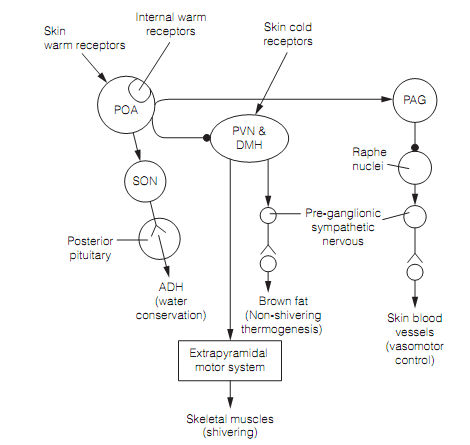Thermoregulation
A core temperature of about37oC is sustained by behavioral and physiological techniques. The core is defined as inside of the trunk, head, and limbs, from deep to the subcutaneous fat layer. Behavior, for illustration seeking sun or shade, curling up whenever cold (to reduce the surface area for radiation), building shelter, and wearing clothes, is required to defend against all but modest alters in environmental temperatures.Physiological heat loss or gain mechanisms are activated when the ambient temperature moves outside the thermo-neutral zone, a window about 1oC broad in which an individual feels relaxed. The thermo-neutral zone based on wind velocity, humidity, and clothing. For naked humans in still air at 50% relative humidity it is 28oC.
The initial response to ambient temperature moving outside the thermo-neutral zone is adjustment in firing of sympathetic nerves to smooth muscles of skin arterioles. In heat stress, firing is decreased and the fall in noradrenaline suggested vascular smooth muscle contraction causes cutaneous vasodilation. This warms the skin, raises heat loss by radiation. In the cold, raised sympathetic activity causes cutaneous vasoconstriction.
Larger excursions from the thermo-neutral zone remind either sweating or shivering. The sweat glands are innervated by sympathetic neurons which are a typical in secreting acetylcholine instead of noradrenaline. ACh acts on muscarinic receptors to trigger sweat production that causes skin cooling by evaporation. Shivering is the roughly simultaneous contraction of agonist–antagonist muscle pairs. It begins in jaw muscles and extends to the trunk and proximal limb muscles. Shivering is brought around by activation of brainstem reticular neurons which synapse with γ fusimotor neurons. The contractions of intrafusal fibers excite stretch reflexes. Therefore, shivering is mediated peripherally by the somatic not the autonomic nervous system. The muscle contraction, both in shivering or exercise, produces heat.
A further heat gain method non-shivering thermogenesis, is particularly significant in human babies. It is caused by raised sympathetic activity to brown adipose tissue (BAT), mainly situated in the neck and among the shoulder blades. Discharged noradrenaline acts on β3 adrenoceptors to stimulate an increase in cAMP.
This activate lipolysis, liberating free fatty acids that are metabolized by β-oxidation in BAT mitochondria, and at similar time uncoupling oxidative phosphorylation in the mitochondria, producing heat.The pre-optic area (POA) of the hypothalamus has internal warm thermoreceptors which monitor core temperature, and acquires input from skin warm receptors as shown in figure. And hence, the POA has several warm-sensitive neurons. It plans to the periaqueductal gray that then relays through the raphe nucleus to preganglionic sympathetic neurons in the intermediolateral column of the spinal cord. This is the route by which vasomotor tone is settled. Additionally the POA stimulates the supraoptic nucleus to secrete antidiuretic hormone from the posterior pituitary. This helps preserve water. The paraventricular (PVN) and dorsomedial hypothalamic (DMH) nuclei acquire input from skin cold receptors and stimulate brown fat and shivering.

Figure: Neural control of thermoregulation. Here, PAG=periaqueductal gray; POA=pre-optic area; PVN=paraventricular nucleus; DMH=dorsomedial hypothalamus; SON=supraoptic
Warm sensitive neurons in the POA adjust both heat losses, through the vasomotor pathway, and the heat gain methods by inhibiting the PVN & DMH. The integration of thermoregulatory responses by the hypothalamus is demonstrated by the fact that thresholds for activating either sweating or shivering can modify. Therefore during exercise sweating, triggered by internal warm thermo-receptors in the POA as core temperature increses, is decreased in a linear fashion the colder the skin temperature.
The core temperature sustained by thermoregulation is the set point. It is equal to a thermostat and is given by the activity of interneurons in the hypothalamus which are not temperature sensitive. These are regulated by catecholaminergic neurons in the pontine reticular formation, and the set point is not steady. It illustrates a circadian rhythm, falling around 0.5oC during sleep, and is raised by progesterone during the luteal phase of the menstrual cycle by about similar amount. The Chronic exposures to hot or cold environments cause regular long-term shifts of the set point.